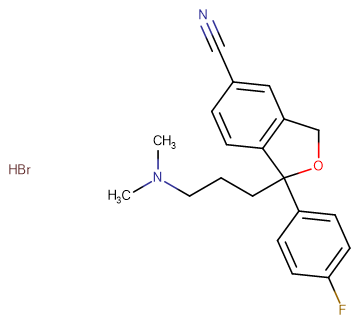
Citalopram HBr
CAS No. 59729-32-7
Citalopram HBr( Bonitrile | Lu 10-171B | Nitalapram | Prepram )
Catalog No. M15219 CAS No. 59729-32-7
Citalopram hydrobromide belongs to a class of antidepressant agents known as selective serotonin-reuptake inhibitors (SSRIs).
Purity : >98% (HPLC)
 COA
COA
 Datasheet
Datasheet
 HNMR
HNMR
 HPLC
HPLC
 MSDS
MSDS
 Handing Instructions
Handing Instructions
| Size | Price / USD | Stock | Quantity |
| 10MG | 36 | In Stock |


|
| 50MG | 74 | In Stock |


|
| 100MG | 101 | In Stock |


|
| 200MG | 141 | In Stock |


|
| 500MG | Get Quote | In Stock |


|
| 1G | Get Quote | In Stock |


|
Biological Information
-
Product NameCitalopram HBr
-
NoteResearch use only, not for human use.
-
Brief DescriptionCitalopram hydrobromide belongs to a class of antidepressant agents known as selective serotonin-reuptake inhibitors (SSRIs).
-
DescriptionCitalopram hydrobromide belongs to a class of antidepressant agents known as selective serotonin-reuptake inhibitors (SSRIs). Citalopram and its N-demethylated metabolites exist as a racemic mixture but its effects are largely due to the S-enantiomer, S-citalopram and S-demthylcitalopram. Despite distinct structural differences between compounds in this class, SSRIs possess similar pharmacological activity. As with other antidepressant agents, several weeks of therapy may be required before a clinical effect is seen. SSRIs are potent inhibitors of neuronal serotonin reuptake. They have little to no effect on norepinephrine or dopamine reuptake and do not antagonize α- or β-adrenergic, dopamine D2 or histamine H1 receptors. During acute use, SSRIs block serotonin reuptake and increase serotonin stimulation of somatodendritic 5-HT1A and terminal autoreceptors. Chronic use leads to desensitization of somatodendritic 5-HT1A and terminal autoreceptors. The overall clinical effect of increased mood and decreased anxiety is thought to be due to adaptive changes in neuronal function that leads to enhanced serotonergic neurotransmission. Side effects include dry mouth, nausea, dizziness, drowsiness, sexual dysfunction and headache. Side effects generally occur within the first two weeks of therapy and are usually less severe and frequent than those observed with tricyclic antidepressants. Citalopram is approved for treatment of depression. Unlabeled indications include mild dementia-associated agitation in nonpsychotic patients, smoking cessation, ethanol abuse, obsessive-compulsive disorder (OCD) in children, and diabetic neuropathy. Citalopram has the fewest drug-drug interactions of the SSRIs. (In Vitro):Citalopram(25-150 μM) shows a concentration-dependent cytotoxicity on the viability of rat B104, human SH-SY5Y, IMR32 and Kelly neuroblastoma cell lines and human primary Schwann cells (HSC).(In Vivo):Acute administration of Citalopram (1-10 mg/kg, i.p. 1 h before an elevated plus-maze test) to Spontaneously Hypertensive rats (SHRs), Lewis (LEW) rats, and Wistar-Kyoto (WKY) rats, i.e., rat strains differing for their emotionality, promotes anxiety, and/or hypoactivity, except in WKY rats. In the three strains, such a pretreatment increased central 5-HT levels and/or decreased 5-hydroxyindoleacetic acid levels.
-
In Vitro——
-
In Vivo——
-
SynonymsBonitrile | Lu 10-171B | Nitalapram | Prepram
-
PathwayEndocrinology/Hormones
-
Target5-HT Receptor
-
Recptor5-HT
-
Research AreaNeurological Disease
-
Indication——
Chemical Information
-
CAS Number59729-32-7
-
Formula Weight405.31
-
Molecular FormulaC20H21FN2O·HBr
-
Purity>98% (HPLC)
-
Solubilitysparingly soluble in Water
-
SMILESBr.CN(C)CCCC1(OCC2=C1C=CC(=C2)C#N)C1=CC=C(F)C=C1
-
Chemical Name——
Shipping & Storage Information
-
Storage(-20℃)
-
ShippingWith Ice Pack
-
Stability≥ 2 years
Reference
1.Bareggi SR, et al. Expert Opin Drug Metab Toxicol. 2007 Oct;3(5):741-53
molnova catalog



related products
-
Lorcaserin
Lorcaserin(APD356) is a selective full agonist of human 5-HT2C receptor with Ki of 15 nM.
-
Desipramine hydrochl...
A tricyclic dibenzazepine compound that potentiates neurotransmission.
-
Tryptamine
Tryptamine is a monoamine alkaloid found in plants, fungi, and animals. It contains an indole ring structure, and is structurally similar to the amino acid tryptophan, from which it derives its name.



 Cart
Cart
 sales@molnova.com
sales@molnova.com


